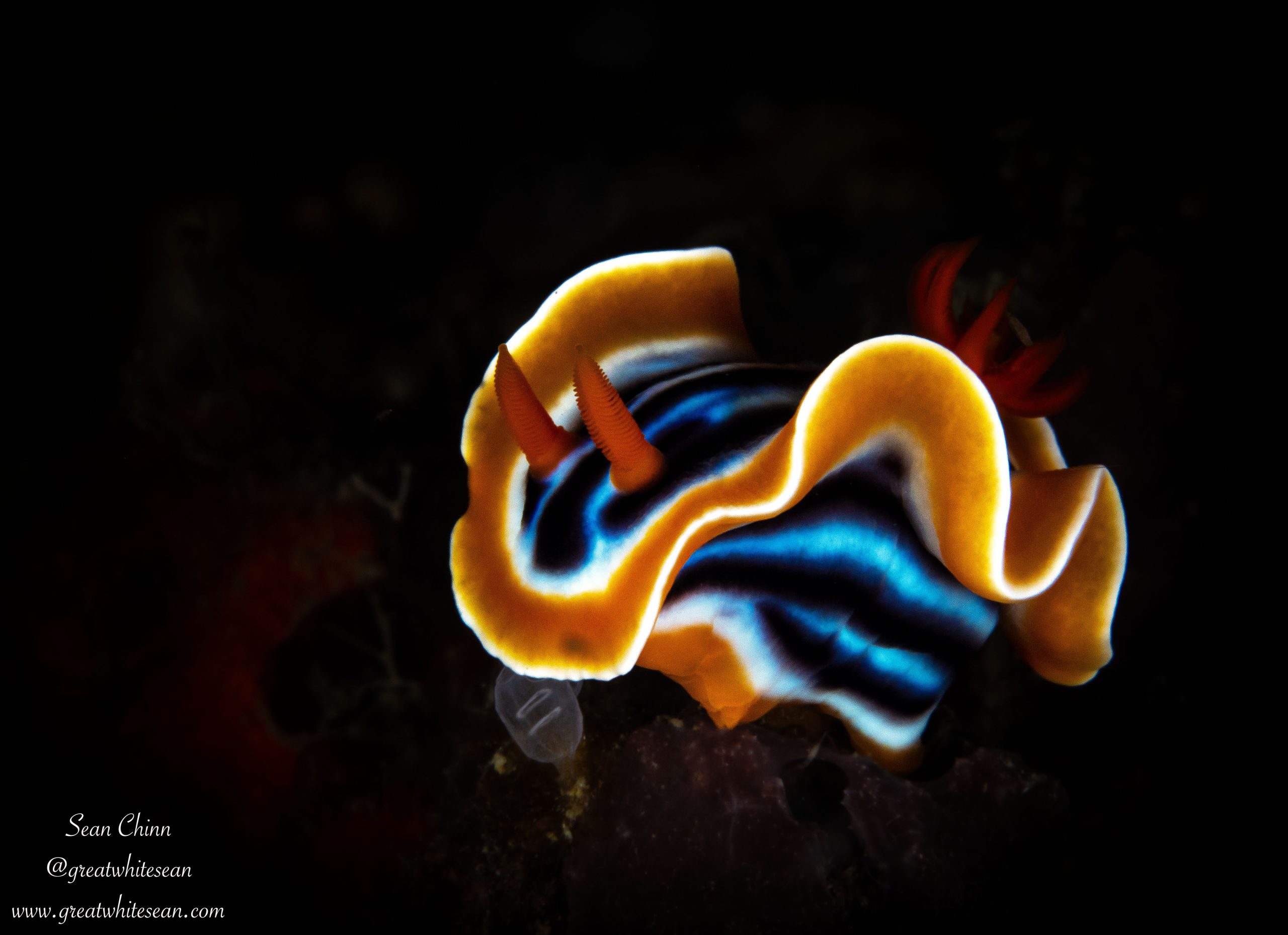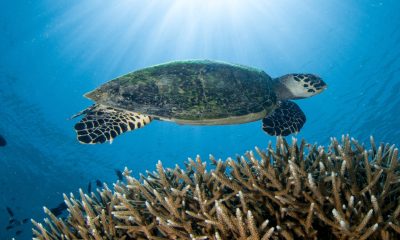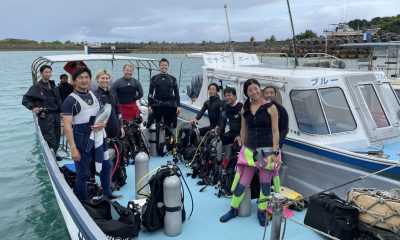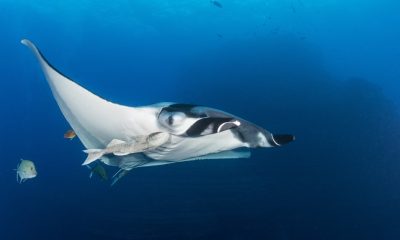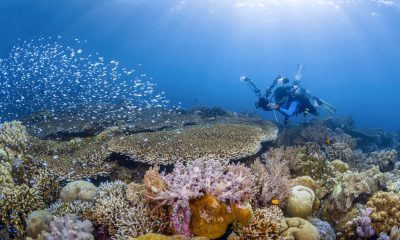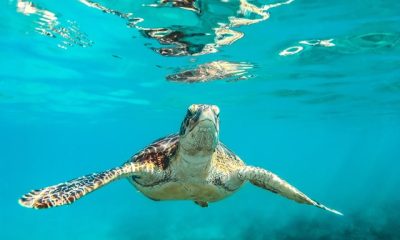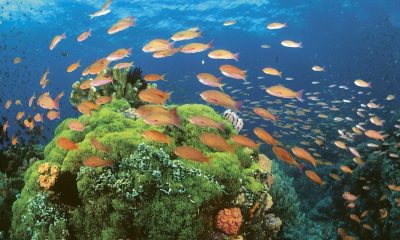News
Diving With Seaventures Dive Rig, Mabul Sipadan, Celebes Sea, Malaysia

In this ongoing series, we speak with the people who run dive centres, resorts and liveaboards from around the world about their businesses and the diving they have to offer…
What is your name?
Pete Hamerton
What is the name of your business?
Seaventures Dive Rig

What is your role within the business?
Dive Team Manager
How long has the business operated for?
Since 1997
How long have you dived for, and what qualification are you?
I learnt to dive in 2003 and became an Instructor in 2009. I am currently a PADI IDC Staff Instructor, Tec Deep Instructor, TDI Advanced Trimix Diver and IANTD Full Cave Diver.

What is your favorite type of diving?
Other than teaching diving, I enjoy Caves, Deep Walls, Wrecks and Muck Diving.
If you could tell people one thing about your business (or maybe more!) to make them want to visit you what would it be?
Seaventures Dive Rig is the world’s first and only oil rig that has been re-purposed into a dive resort. We offer daily dive trips to Sipadan, regularly voted as one of the best dive locations in the world. And we offer daily diving at Mabul Island – macro-diving heaven! But it’s not just the diving that we love. The whole experience of living on a former oil rig is a one of a kind experience. Rooms are small but comfortable. There is an almost 360 degree view of the Celebes Sea with great sunrises and sunsets. We pride ourselves on having an extremely experienced, friendly, multi-lingual and safety-conscious dive team. Finally, we pride ourselves on providing superb customer service – both topside and underwater – and excellent food.

What is your favorite dive in your location and why?
The Rig’s house-reef is definitely a favourite if you love macros. Nudibranch, pygmy seahorse, frogfish, and the ornate ghost pipefish are just some that you will see under the Rig. Other than that we love Turtle Tomb and South Point. Both are famous dive sites at Sipadan. Turtle Tomb is a cave system that stretches for several hundred metres under Sipadan Island. It contains the perfectly preserved skeletons of about 20 dead Turtles and a dead Dolphin. We think they have found their way into the cave through a hole in the reef wall and were unable to find their way out. It’s an unforgettable dive and a really unique cave system.
South Point is an awesome wall dive on the South side of Sipadan Island. The wall starts at about 10m and stretches into the abyss – 600m below…! It’s great for recreational diving, Tec diving and Freediving (we are a PADI TecRec and Freediving centre). The wall is covered in vibrant soft and hard corals; we regularly see numerous Green and Hawksbill turtles and we regularly see different types of Sharks cruising past in the blue.

What types of diving are available in your location?
Recreational diving, Tec diving, Freediving, Rebreather diving, Wall diving, Macro diving, Drift diving and Night diving.
What do you find most rewarding about your current role?
Working with people and being in the ocean. Whether that’s a PADI Open Water student learning neutral buoyancy for the first time, guiding an experienced cave diver into Turtle Tomb, mentoring an Instructor candidate about to take their Instructor Exam or working with a diverse, dedicated, talented and multi-lingual group of colleagues.
At Seaventures we’re fortunate to have an awesome dive team who, between them, have over a hundred years of diving experience. I’m constantly impressed by our dedicated and hard-working team who always strive to show our customers the best of Mabul and Sipadan Islands, prioritise safety and make their guests smile. We also have some great customers from all over the world – and it’s a real pleasure to watch their faces as they come on to the rig for the first time (all of the team who aren’t diving personally greet arriving customers).

What is your favorite underwater creature?
Ornate Ghost Pipefish. I love their shape, colours and get a real sense of satisfaction whenever I find one….because they’re quite hard to find!
Are there any exciting changes / developments coming up in the near future?
Absolutely. We’ve just become a PADI Freediver centre and are really excited to start offering Freediving courses, as well as guided freediving, for our guests. We’re the first dive centre in the area to offer freediving and one of the few to offer Tec and Cave diving for our customers.
In addition, we’ve just finished our first Ocean Conservation week. As a busy dive resort, we’re acutely aware of some of the threats facing the ocean. We always try and educate our students and guests on the importance of preserving the marine environment – but we also want to have a set period every year where we relentlessly focus on this. We’re not only working with our guests and local community to educate them about some of the threats facing the marine environment, and what they can do to help, but we’re also looking at our business practices. For example, this year, we have stopped providing our guests with plastic bottled water. Instead, we’re providing re-fillable glass bottles. It may seem like a small change, but if you scale that up, that’s a significant reduction in the amount of plastic that we’re generating every year.
As a center what is the biggest problem you face at the moment?
It’s not a quite a problem but more of a challenge. Our Rig is located 45 minutes away from the nearest town (although we’re only minutes away from Mabul Island and only twenty minutes from Sipadan) so everything has to be transported in by boat. As such, we try and anticipate guest’s needs by having a well-stocked shop on the rig. In addition, because we are located literally above the water, every decision we make to use, install or build something has to consider the environmental impact that will have.

How do you see the SCUBA / Freediving / snorkeling industry overall? What changes would you make?
The team at Seaventures has over a hundred years of diving experience between them. We have seen many changes in that time. A few that we are especially conscious of:
- A much greater focus and urgency on the threats facing the ocean, and, with the support of partners like Project AWARE, a means to address some of these.
- Increased popularity of Freediving and Tec (both of which we offer). Including the recreational rebreather market.
- Especially in South-East Asia and Australia, there has been a massive increase in the number of Chinese divers. This is great, and has significantly changed the market across every aspect of the business.
Markets evolve for a variety of reasons and in a variety of ways. Working in the dive industry, we have the ability to both shape and respond to some of those changes. We’ve seen a huge increase in the volume of divers and the speed at which we can get people into the water. That’s great. But we also need to make sure that students, from the very beginning, are learning and mastering good buoyancy skills and safety habits. This should be an integral part of their diving habits and is crucial for environmental and safety reasons.

What would you say to our visitors to promote the diving you have to offer?
Well, we dive every day at Sipadan and Mabul islands. They are both world-renowned dive locations that never fail to impress guests. And we are the world’s first oil rig that has been re-purposed as a dive resort. But on top of that, we strive to offer three things without fail: un-compromising safety standards; excellent standards of service and experience topside and underwater; and, like any business, sales.
On the last point, we take the time to listen to where customers are in their diving career and match the appropriate diving course or experience to them. If that’s a PADI DSD or a guided cave dive, we can offer it. We offer a wide range of diving courses and experiences, have an experienced and multi-lingual team, and have the benefit of a huge variety of diving options (Caves, Deep, Macro, Walls, Drift etc.)– so we don’t just blindly push the next course on to customers – we work out where they are and want to go with their diving, and try and help them get there.

Where can our visitors find out more about your business?
If you would like to know more about scuba diving and living on a former oil rig, email us at info@seaventuresdive.com or visit our website at www.seaventuresdive.com. We are also reachable at +6088 251 669 if you wish to speak to us.
You can also follow us on our social media pages for updates at:
https://www.facebook.com/seaventures
https://plus.google.com/107344633898864939260
https://instagram.com/seaventuresdiverig
https://twitter.com/Seaventures

Blogs
A Welcome Return (Part 2)
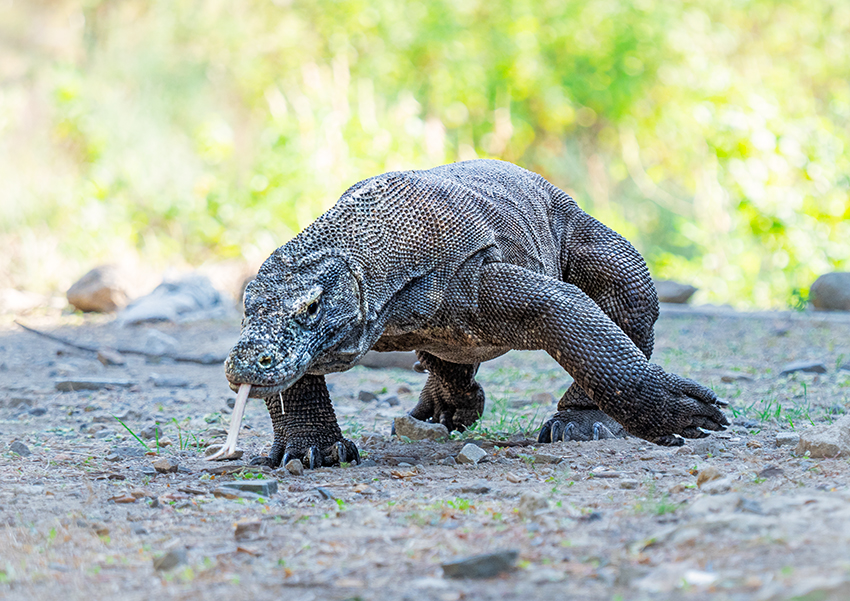
I’m hoping by now you would have read Part 1 of my ‘A Welcome Return’, all about joining La Galigo Liveaboard once again, but this time exploring the delights of Komodo National Park.
The trip was really starting to hot up, with great scenery above the water and great encounters underwater. It was the little critters that were stealing the show and it was about to get even better. Here is how the rest of the trip panned out…
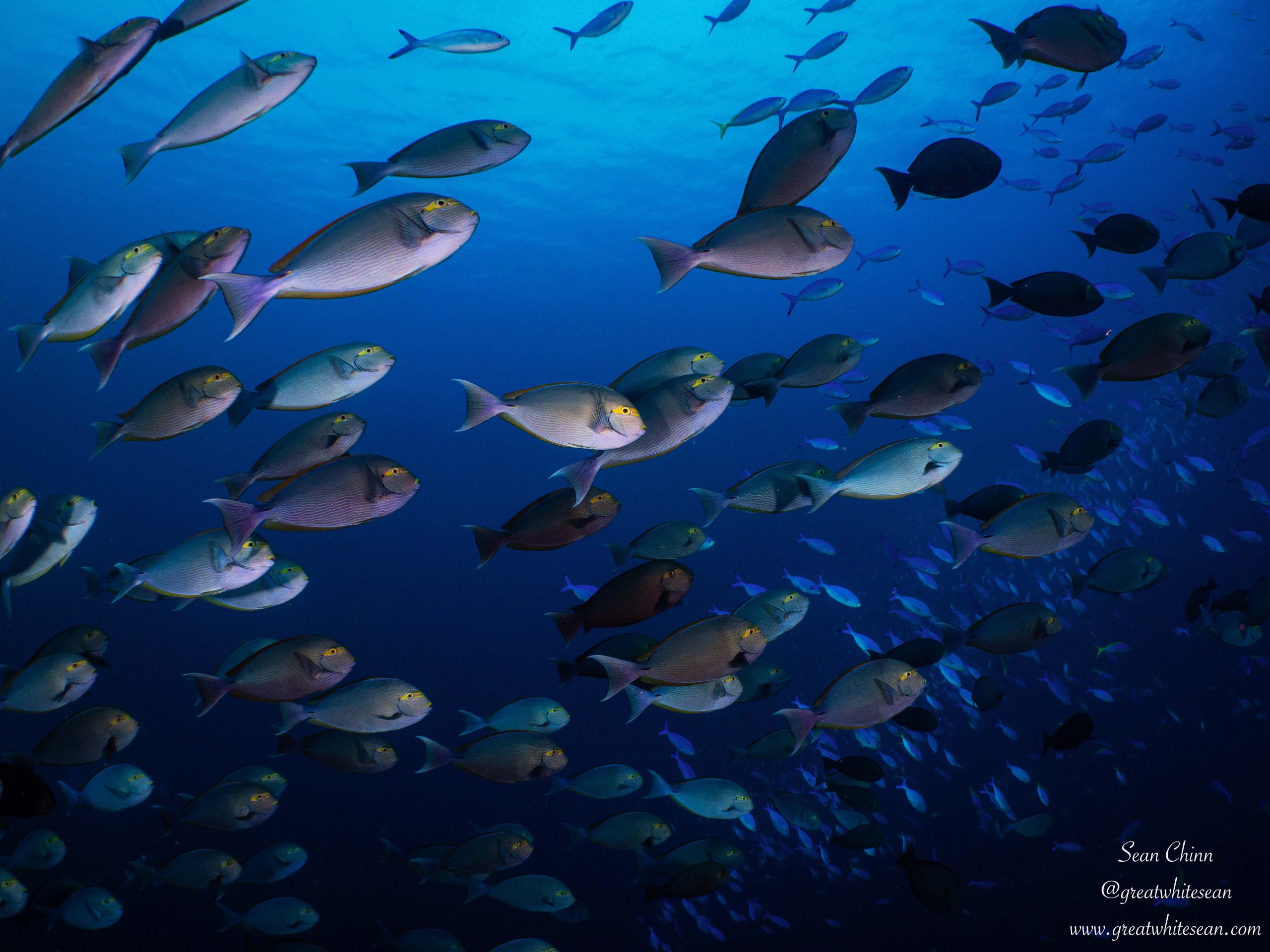
I was more than psyched for day 3. With a dive full of life to start with at ‘Castle Rock,’ followed by what should be an adrenaline-fuelled drift at ‘The Cauldron’ aka ‘Shotgun’, It was sure to be an adventure. Sure enough, once we descended along the pinnacle at ‘Castle Rock’ to around 25 metres, we were surrounded by an abundance of fish life. Numerous banner fish, schools of fusilier and surgeonfish swam in unison, while the odd friendly batfish would come to check each diver out. A distant school of jackfish were joined by the odd tuna and a circling whitetip reef shark to add the predators to the list of life. It was such fun floating amongst the amount of life before letting the current take us onto the reef. A few macro delights were waiting, as a blue ribbon eel and leaffish were spotted, alongside a friendly hawksbill turtle. This was certainly a dive that didn’t disappoint.
It was time for ‘The Cauldron,’ a notorious dive that struck fear into the hearts of some and was legendary to others. Tales of masks flying off in the current made for a little nerves before descending, but excitement from others about how the drift can shoot you through the channel between Gili Lawa Laut and Gili Lawa Darat. However, it was a little different for my dive and the current was fairly mild in comparison to what I expected. It still had enough current for a nice push through the channel and also provided some great marine life encounters. Another new shark species for me was a major highlight, as I finally got to see and photograph a bamboo shark. It was also the site for our only manta ray encounter of the trip. Unfortunately, the manta had passed my group before we saw it and we only got the tail end as it glided through the current away from us. A smaller mobula ray was also spotted at a distance, and a small school of bigeye trevally before… you guessed it… yet another friendly hawksbill on the safety stop.
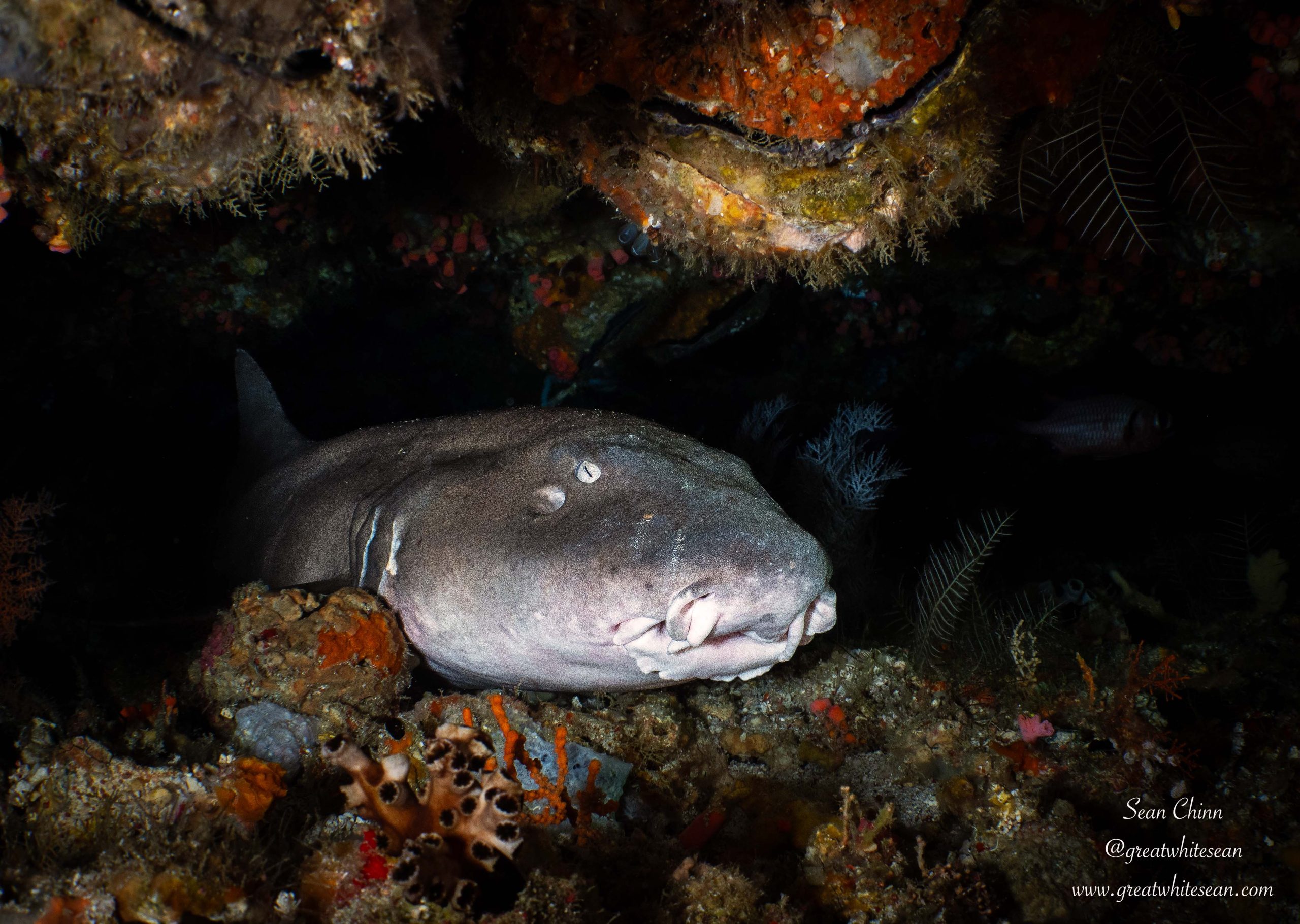
Day 3 was becoming the best diving day so far and I’d say the next dive at ‘Golden Passage’ was my favourite wide angle dive of the trip. I just love cephalopods and am a big fan of cuttlefish. Three rather large broadclub cuttlefish at the very start of the dive were more than welcome and provided great photography opportunities. We then had an amazing drift along the passage with a bit more oomph than ‘Shotgun’. More hawksbill turtles along the way, a sleeping bamboo shark in the overhangs, and a dancing school of fusiliers provided extra marine life joys. We finished the diving day with a night dive at ‘Gili Lawa Darat Bay’. Wow!!!! Once again, critters stole the show, along with a rather successful bobtail squid snooted photography shoot for me. Devil scorpionfish, nudibranch, flatworms, shrimps, squat lobsters and juvenile harlequin sweetlips made sure every single minute was interesting.
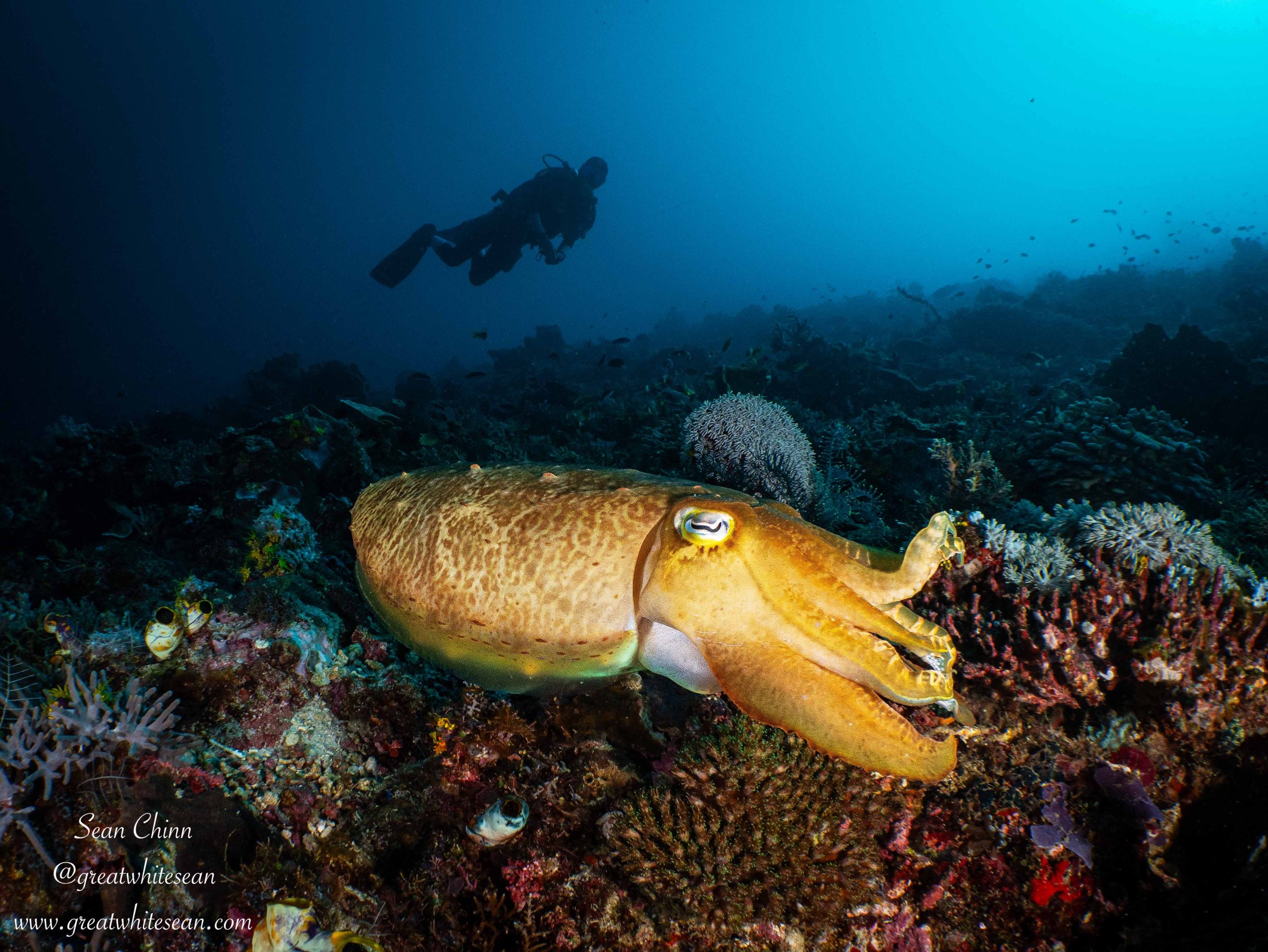
After a short documentary about Komodo dragons on the evening of day 3 to get us excited for seeing them, I was definitely more than excited! Day 4 was a day of giving it our best shot to get some great manta ray action. We started with another beautiful pinnacle reef around ‘Crystal Rock’. Small school of batfish, Napoleon wrasse, whitetip reef sharks, a blacktip reef shark and lion fish greeted us, before we moved on to try for mantas once again. Back to ‘Karang Makassar’ and a drift along the sand and rubble, passing small sections of coral formations that would act as cleaning stations. Unfortunately, we were once again unlucky with our manta ray sightings but this dive did deliver more interesting encounters: A bamboo shark resting out in the open before swimming off, green sea turtles, hawksbill turtles and, once again, a large broadclub cuttlefish.
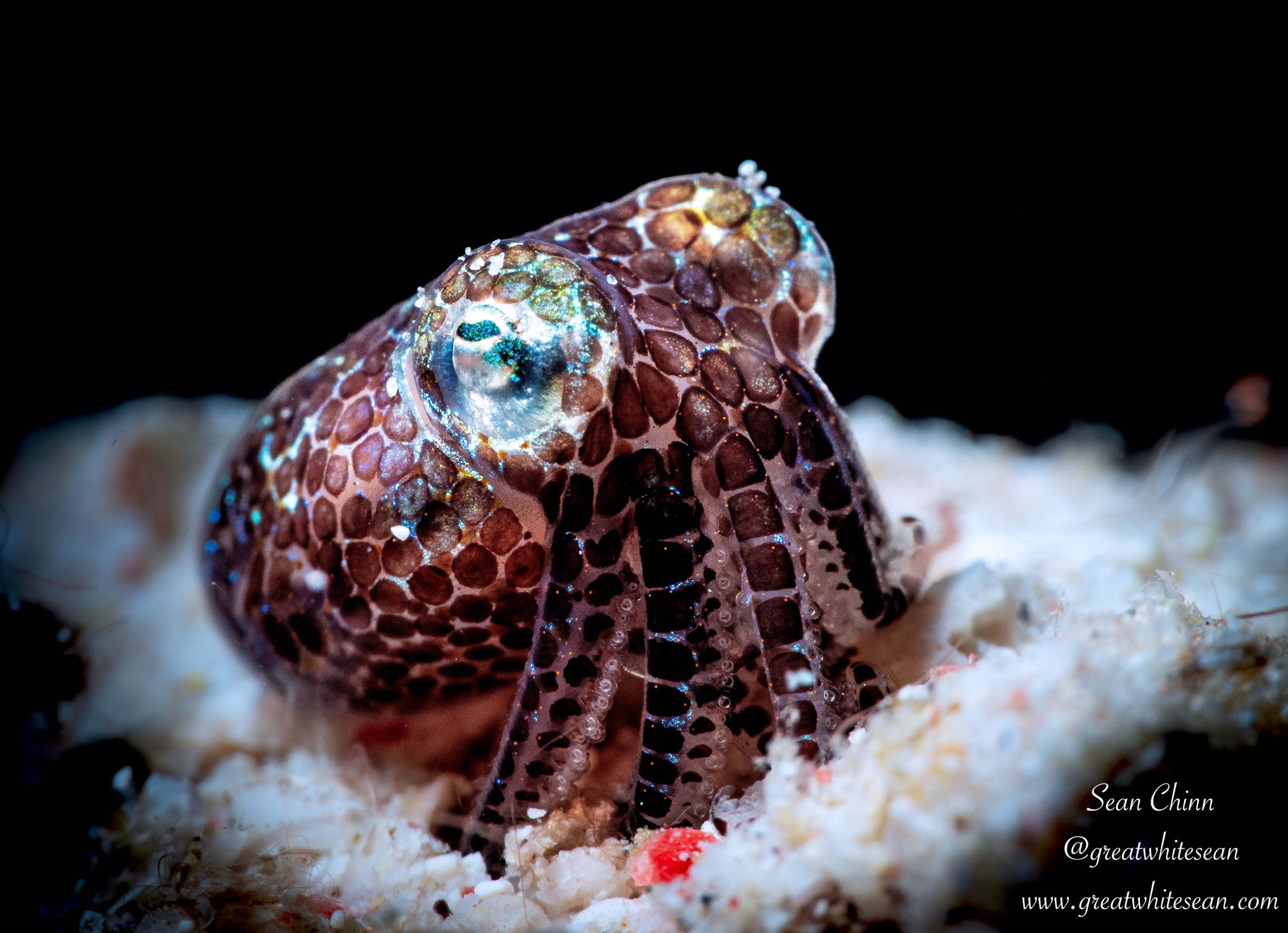
A final day dive at ‘Mauan’ in the hope of seeing mantas wasn’t much to write home about in this instance. We gave it our best shot with the mantas and that’s all we can ask of the accommodating crew onboard. Unfortunately, wildlife doesn’t always play ball and on another trip you could have some of the best manta ray action of your life. However, the final night dive of the trip more than made up for it. Wow, wow, wow!!! What a dive! With some of the most unique critters you can find. So much so, I have been asked to keep the dive site quiet in fear of the information getting to the wrong people and bad practice being at play. A shame it has to be that way but a necessity at times. While numerous species of nudibranch were spotted on the dive, it was the elusive ghost melibe that stole the show. A transparent nudibranch made up of white lines, giving it a skeletal appearance that was hard to photograph but soooo exciting to see!
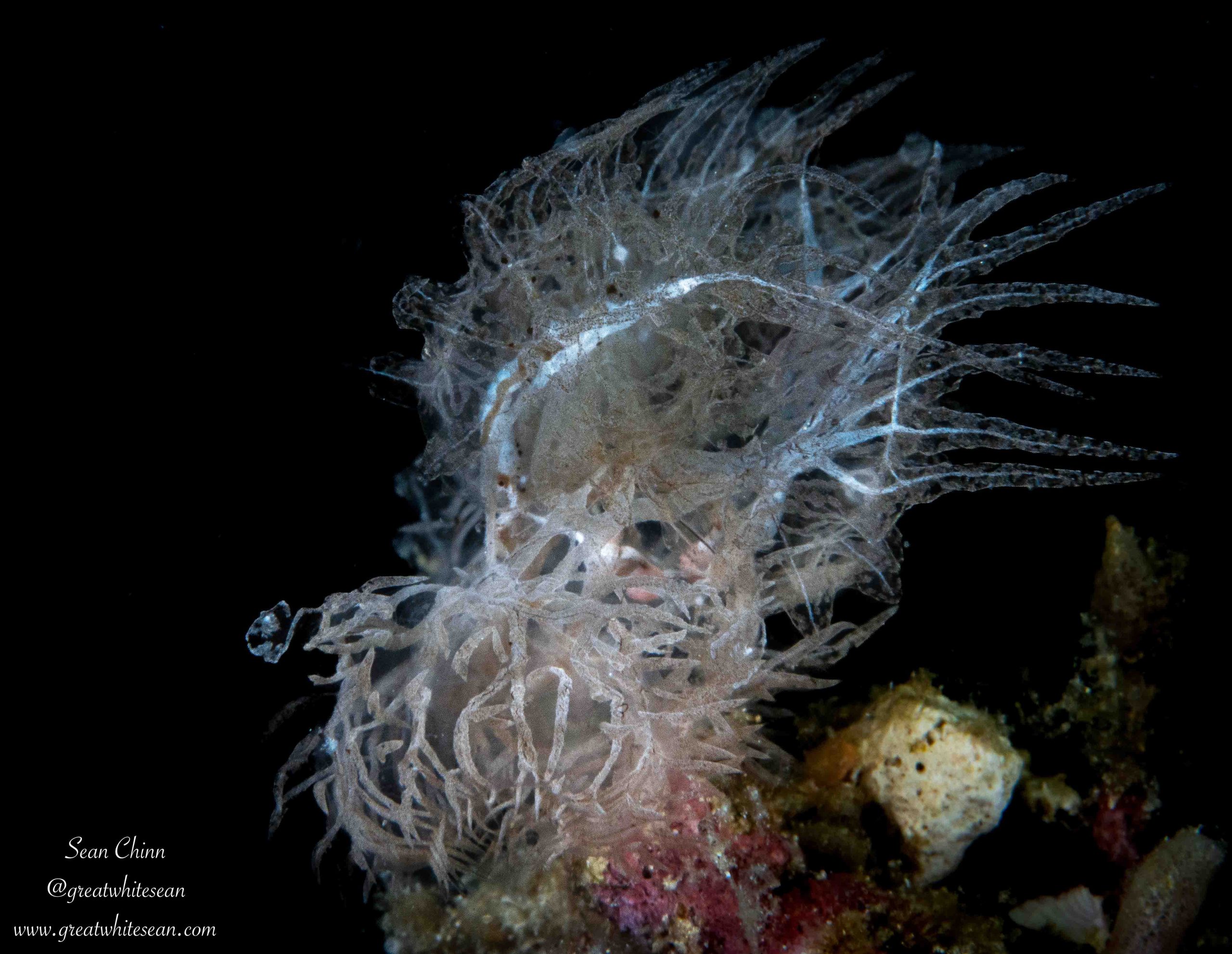
The unique critters didn’t stop there, as another highlight macro critter – the paddle flap scorpionfish – was spotted to the excitement of the guides and cruise director Fareez, who screamed and danced (with excitement!) underwater. Definitely a sought-after critter in the underwater photography world, and we had two join us for the dive. There was a lot of sand and sediment in the water, making it difficult for photography and I wasn’t completely ecstatic with the shots I got, but loved to see another new-to-me species. But guess what? The fun didn’t stop there, as a black frogfish was sitting under some broken coral just next to the scorpionfish. WHAT A DIVE!!!!!!
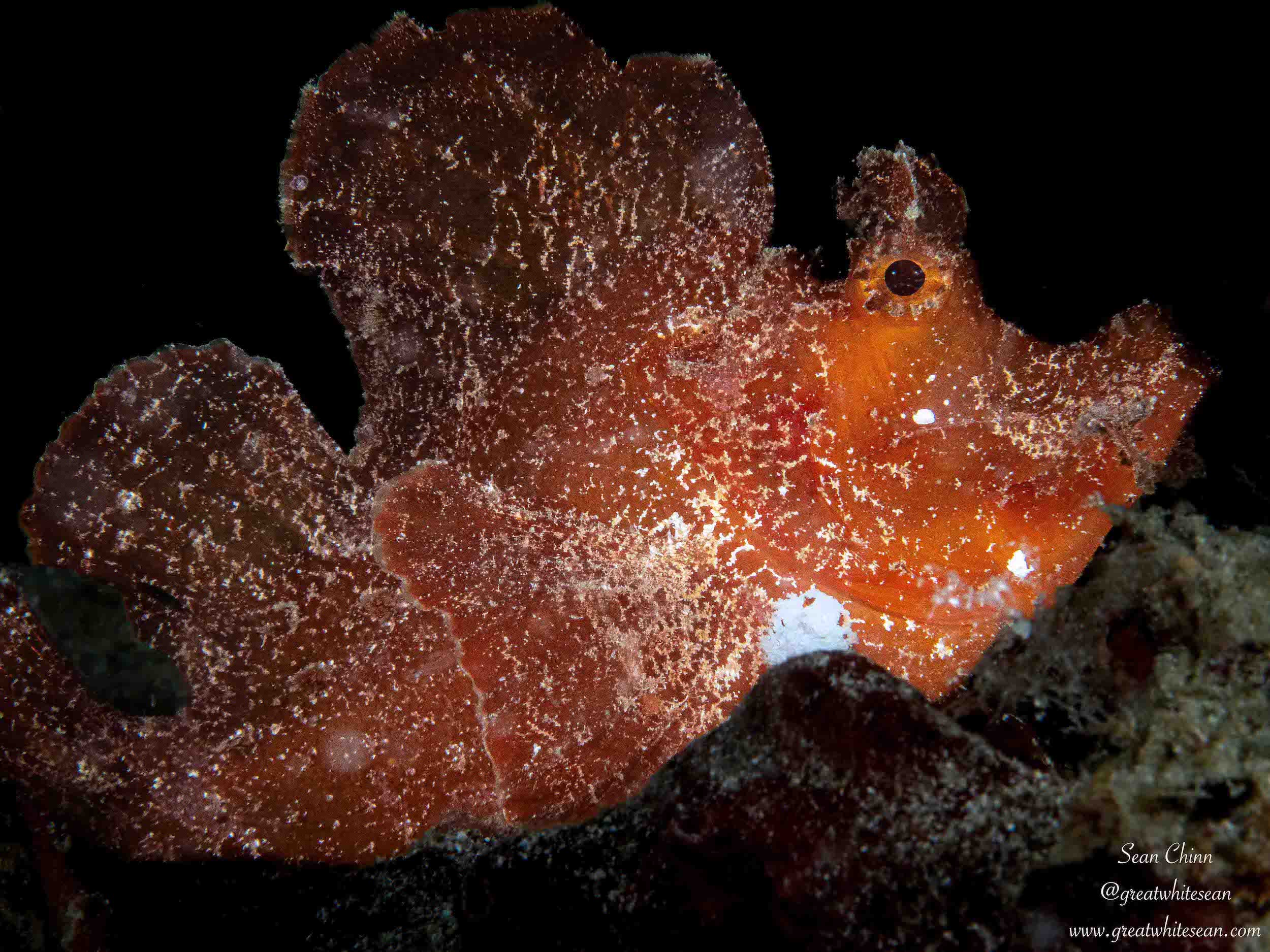
After such an incredible final night dive, the final day also finished the trip in incredible fashion, ensuring the need to return was firmly there. Starting with a first dive at Pengah, where a banded sea krait hunting throughout the reef was a great start, and more colourful coral formations around the pinnacle, with amazing hard coral just below the surface. It was a dive for wide angle and macro, as ladybugs, different nudibranch, and a leaf scorpionfish were found. As well as a large octopus working its way through the reef before hiding when we locked eyes. The final dive really put the icing on the cake. It was a macro dive amongst sand and rubble: numerous nudibranch again dazzled, with the ‘Pikachu’ nudi my favourite. Peacock mantis shrimp, spearing mantis shrimp, longhorn cowfish, orangutan crab, squat lobster and shrimp ensured a special dive before the grand finale – a thorny seahorse. What a dive and what diving for my five days in Komodo National Park.
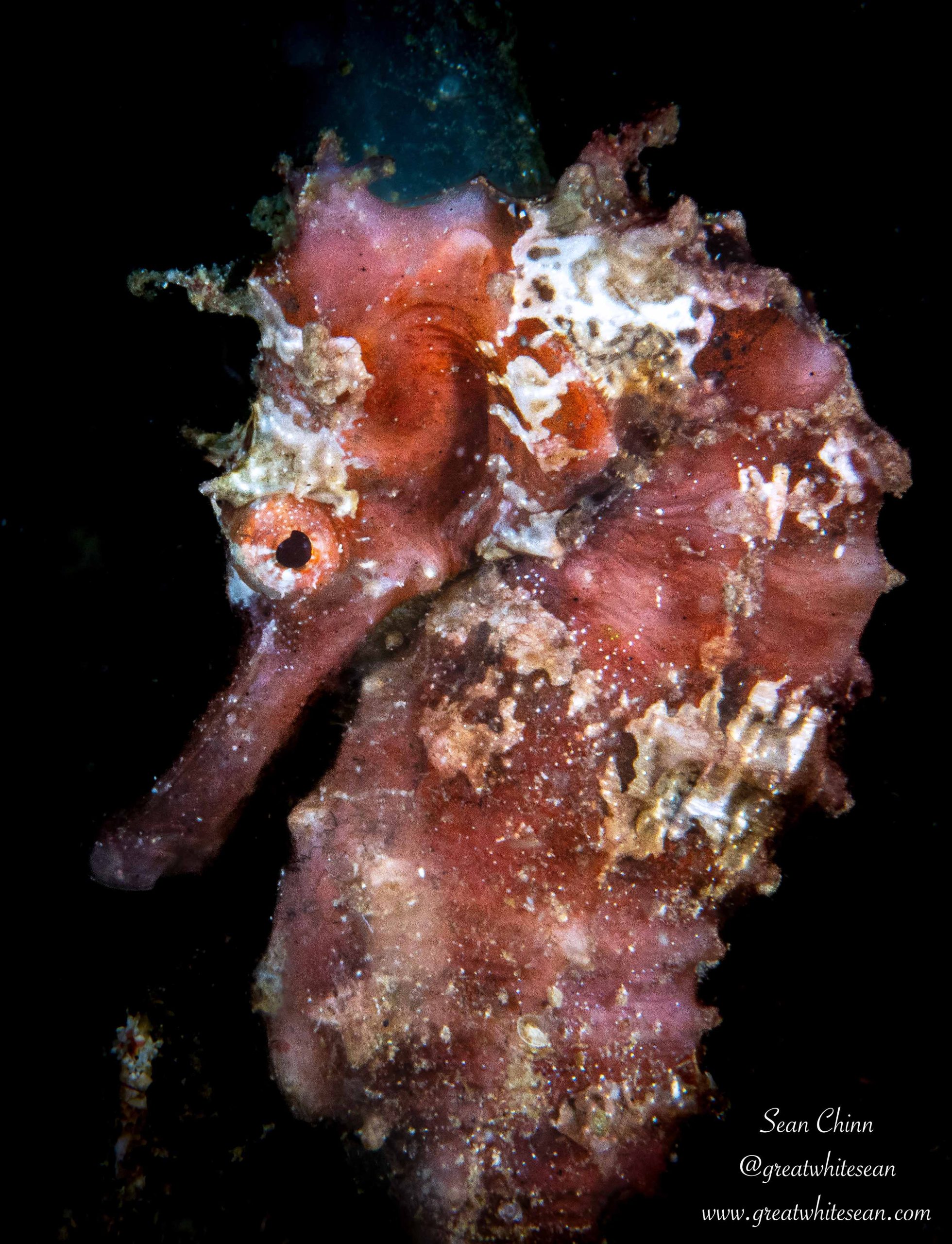
Well, the diving might have been over, but the trip certainly wasn’t. In fact, it was time for one of the tours I’d been looking forward to the most. Time to see Komodo dragons on Rinca Island. As much as I love liveaboards, it’s always nice to get back on land. A jetty led us onto a boardwalk path, where within minutes we laid our eyes on our first dragon, before getting closer to the information centre and seeing the big male that commands the area. Sprawled out on the floor, his size was immense. A great start but I longed for those close encounters and not looking down from a platform.
We were soon through the information centre and onto the wild ground to start our very short trek. We didn’t need to go far at all as a resting large female was just next to the information centre, followed by a small juvenile who came running through stealing all the attention. It was a little cutie and fun to see and photograph. Being a photographer, you always have images in mind before you go somewhere. I was desperate to get a large dragon postured up facing or walking to the camera. I quickly realised that these were lazy animals in the midday sun (as am I). It’s too hot and they risk overheating if they’re too active. I began to lose hope for the shot I wanted, as we trekked a short while up the hill and found another resting female. Amazing to see once again before it was all too soon ready to leave. I could have trekked so much more of the island.
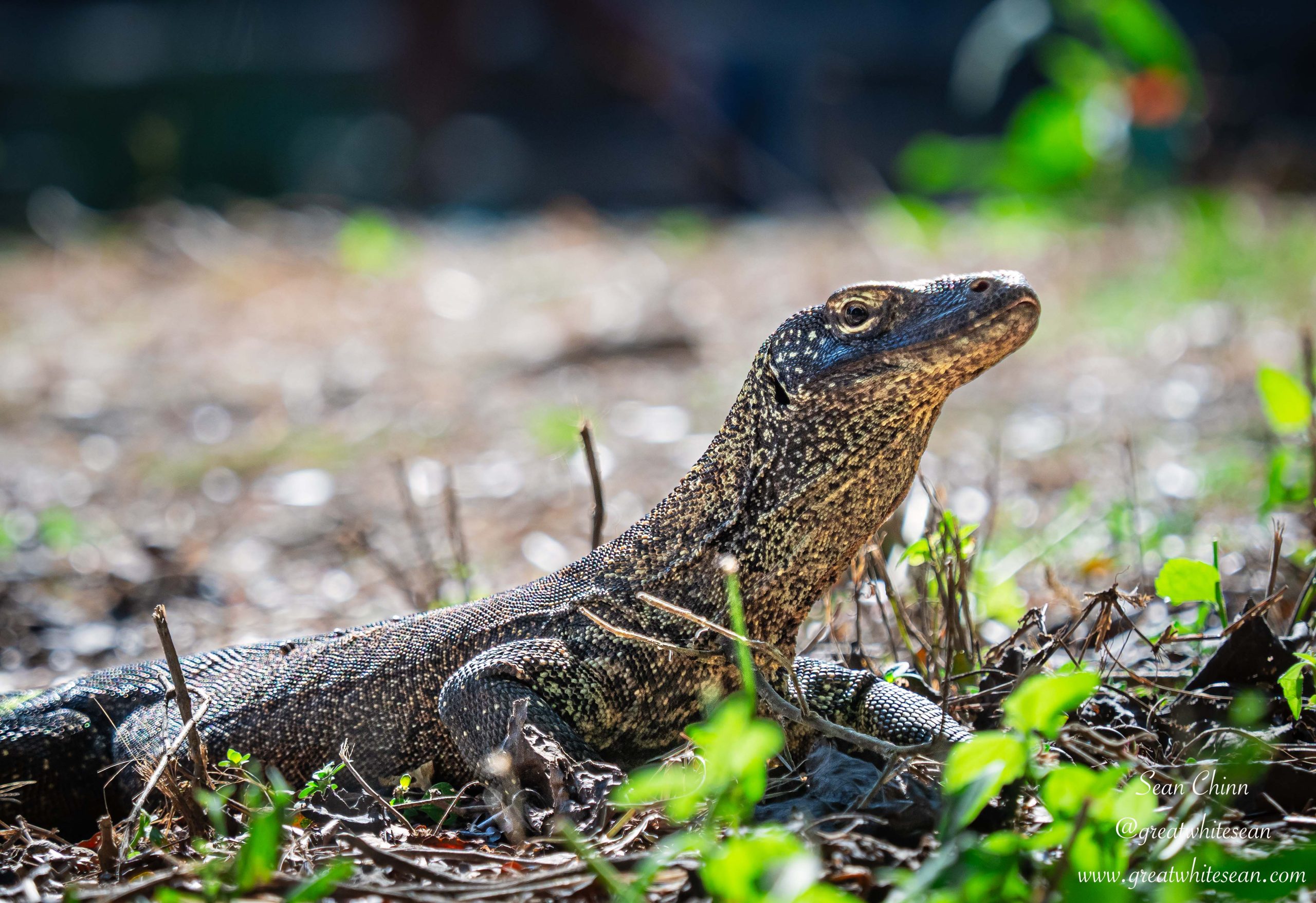
As we waited around the outside seating area of the information centre, I was going through my shots with Fareez and explaining the shots I was hoping for. He said maybe I would get lucky while we waited for the others to explore the gift shop. I knew I didn’t have long. Suddenly, some commotion back outside on the wild ground caught my attention. DOUBLE JACKPOT!!! I went flying out of the gate and there was a dragon walking directly towards me. Postured up, showing off its muscles, only made better by the fact that it was the huge male that swaggered into his arena. Showing off to his adoring crowd. I was completely made up and thankfully got some shots I was happy with. He slowly walked around using his tongue to taste all the flavours, before finally slumping on the ground, sprawled out in the shade.
My trip was now complete, or so I thought. I got what I wanted and was happy to return to my family completely content (apart from losing my drone that is!) That was until the grand finale, the little extra I didn’t know I needed, but it’s always those moments that separate a great trip from an unbelievably fantastic trip. The little extras that make you long to return.
Moored up at Pulau Kalong under an amazing sunset, we waited for the show to start. A spectacle that only nature can deliver soon ensued, as thousands upon thousands of flying foxes left their daytime roost on the island. Engulfing the orange sky with black silhouettes akin to the batman sign. They just kept coming and coming for the next hour or so before we enjoyed an amazing BBQ dinner on the top deck and an incredible show of songs and dance from the amazing crew. Another fantastic trip onboard La Galigo and I can only hope I’ll be back soon.
For more information about diving in Komodo:
Sean Chinn Instagram: @greatwhitesean
Email: sean@greatwhitesean.com
Whatsapp: +62 812 2000 2025
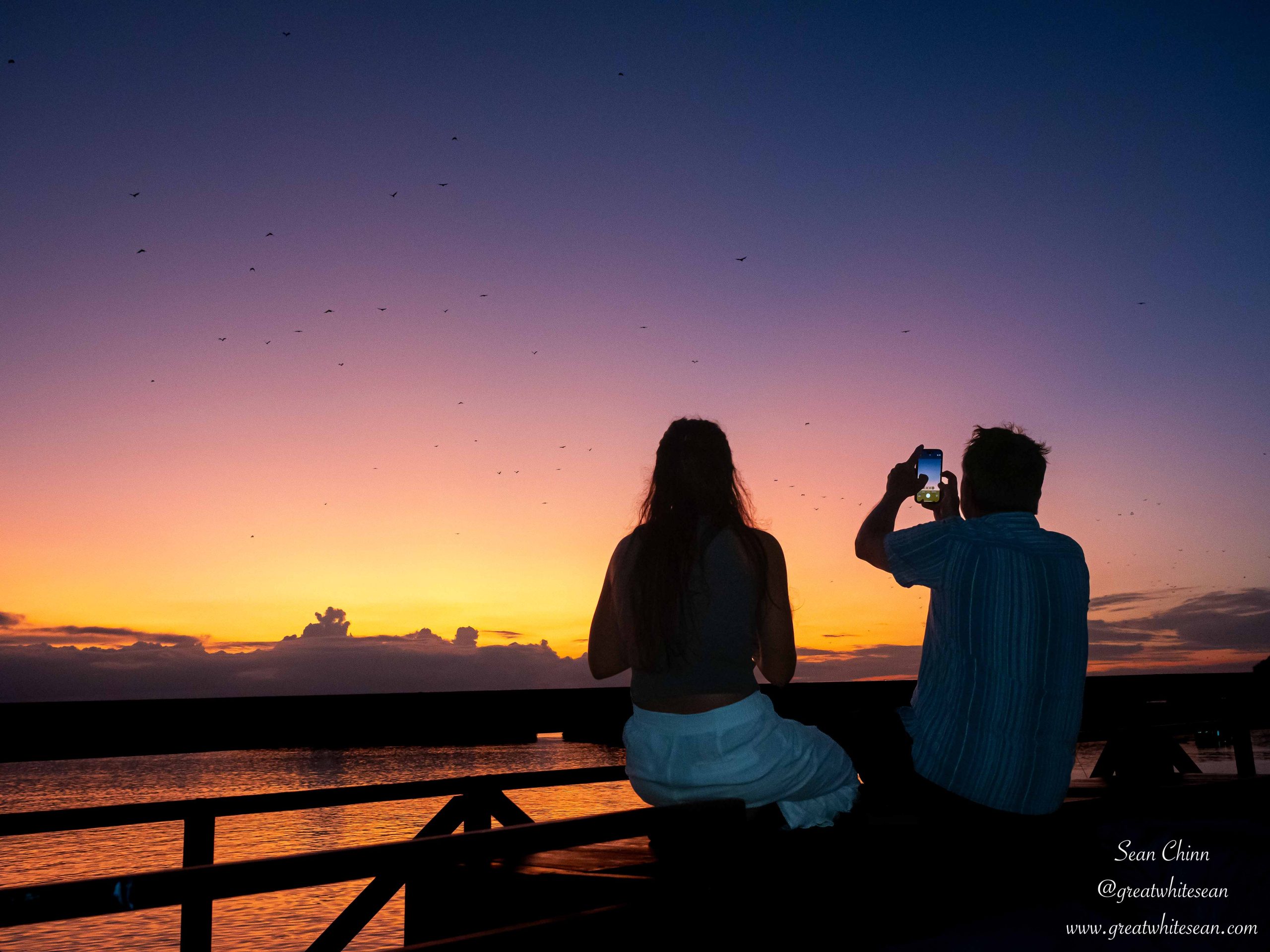
Blogs
A Welcome Return (Part 1)
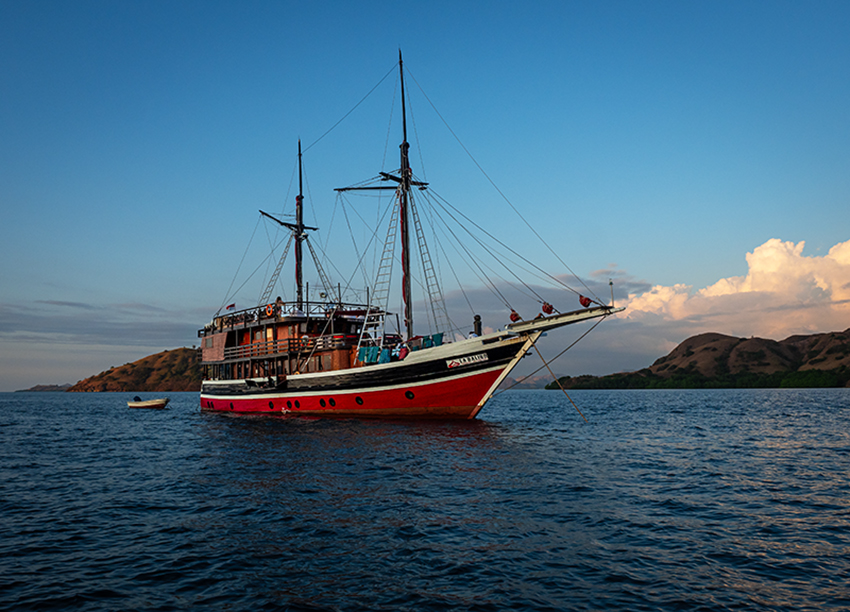
After an incredibly successful trip onboard La Galigo last October exploring Raja Ampat, I was so happy to jump back onboard. This time exploring another bucket list destination – Komodo National Park.
Strangely, it’s not the underwater world around Komodo that makes it such a bucket list destination for me. Growing up fascinated with the biggest species of each animal, the Komodo dragon has been a lifelong ambition for me to see. I was so excited to now get the opportunity, while also knowing the diving around the National Park would be way more than an added bonus. In my mind, Komodo was synonymous with crazy currents, mantas and some suspect visibility at times. I was expecting really tricky adventurous diving. What I found, was actually very surprising to me and left me with a very pleasant content feeling after the trip. Let’s find out what La Galigo’s Jurassic Komodo trip had in store…
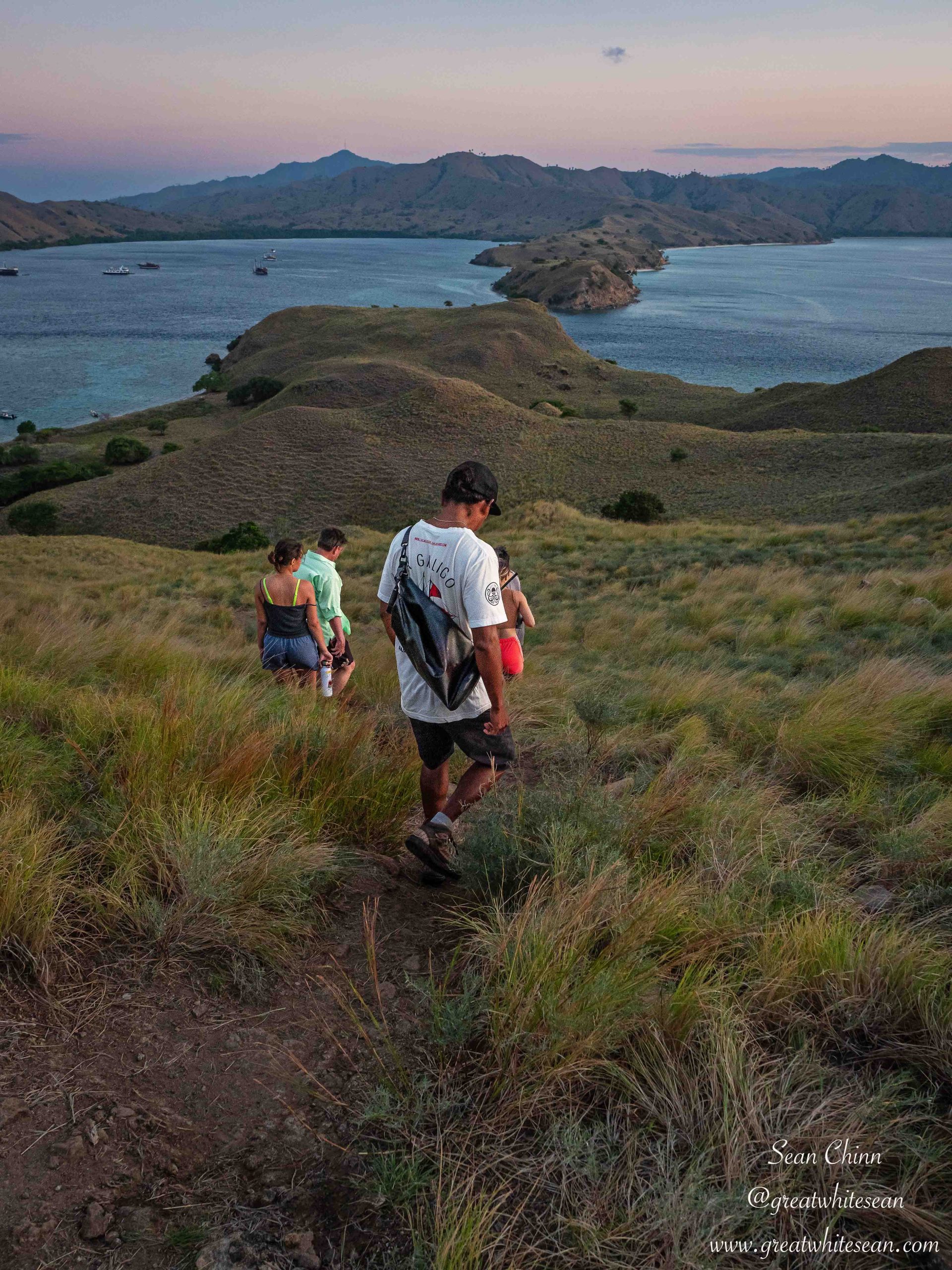
I was on a much shorter trip this time (6D/5N) compared to my Raja trip last year. Now, I’m going to try hard not to compare Komodo with Raja Ampat, but it is hard not to, after doing both trips relatively close in time to each other. However, what I found were two places that complimented each other so well. Their differences are part of their charm and the reason why both are must-do trips. This was evident in the contrasting landscape while exploring the islands around Komodo. The drier climate creating stunning rugged savannah islands rising from the clear blue waters. Covered in a mixture of yellow and green grass, creating a beautiful golden glow at sunrise and sunset. With isolated trees creating a focal point and hillsides leading into idyllic white sand beaches. Another breathtaking area to explore and no better way than to sail from island to island.
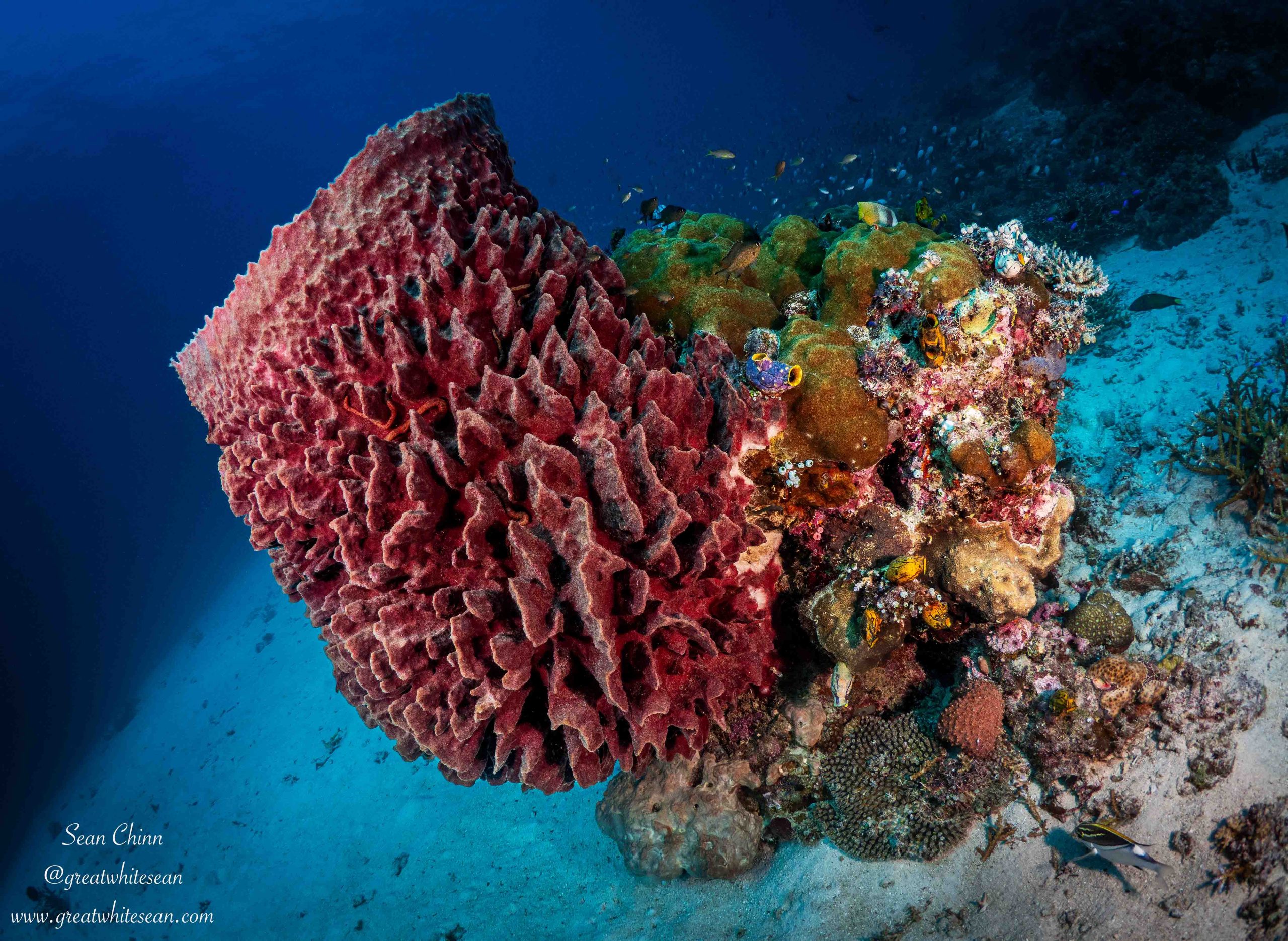
11 guests were onboard for my trip and diving was split into three groups, no more than four divers with each dive guide. A spacious dive deck plenty big enough for the number of guests onboard and two speedboats transporting us to each dive site. An extremely helpful crew providing a comfortable journey and making sure we barely had to lift a finger. The food onboard was again super delicious, with the Soto Ayam being a highlight, while the beef rendang again had my mouth watering. With spacious rooms throughout and comfortable beds and pillows, another relaxing stay was on the agenda between dives. Speaking of dives, let’s see what underwater had in store…
Apologies!! I am going to compare Komodo and Raja Ampat one last time, this time in relation to the check dive. In my mind, before I had dived both, I had Komodo as the place with crazy currents and sometimes poorer visibility, with Raja as the opposite. My check dives couldn’t have been further from what I had imagined. While my dive in Raja was limited vis and a relatively strong current, diving in Komodo started super relaxed, with next to no current and some amazing visibility at ‘Sebayor Kecil’. Such a pleasant start to my Komodo trip with beautiful reefs full of healthy hard and soft coral. Yellow snapper swimming in unison, lion fish, crocodile fish and a blue spotted stingray welcoming me nicely to life underwater in Komodo.
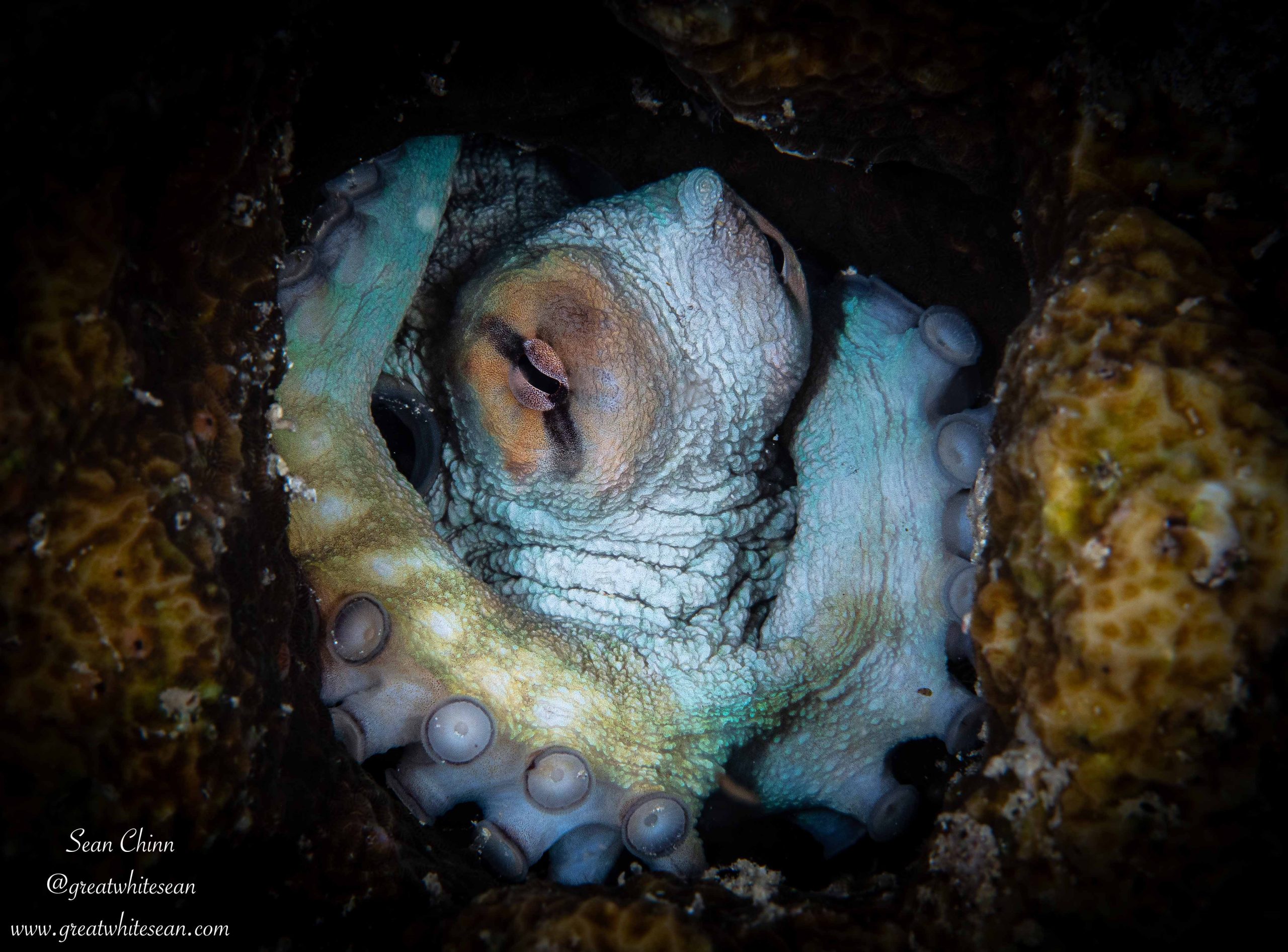
Following on from such a relaxed dive, I soon realised it was the little critters that were going to steal the show in this beautiful paradise. The first night dive at ‘Sebayor Besar’ showed me what treats I had in store for the trip. With a very small red octopus only few centimetres in size, followed by a larger reef octopus. Nudibranch, peacock mantis shrimp, crabs and more made sure every minute of the dive was enjoyed before getting back onboard. The night wasn’t finished, as a fun game of ‘Cards Against Humanity’ broke the ice with everyone onboard and was the perfect example of why I love liveaboards so much. Meeting people from all walks of life while confined to life onboard broadens your horizons. It was a great laugh with a great group.
The next day followed on with some more beautiful reefs full of life. ‘Tarawa Besar’ and the magical ‘Batu Balong’ were the dive sites of choice. A mixture of stunning hard coral formations and vibrant soft coral dazzled like a Van Gogh painting full of colour. It was also the introduction of some friendly turtles, in particular a number of hawksbill that quite happily swam between divers and allowed for close interactions. A grumpy green sea turtle was the highlight for me, as it rested amongst the coral in the final moments of ‘Tarawa Besar’. I just love their patterned shell.
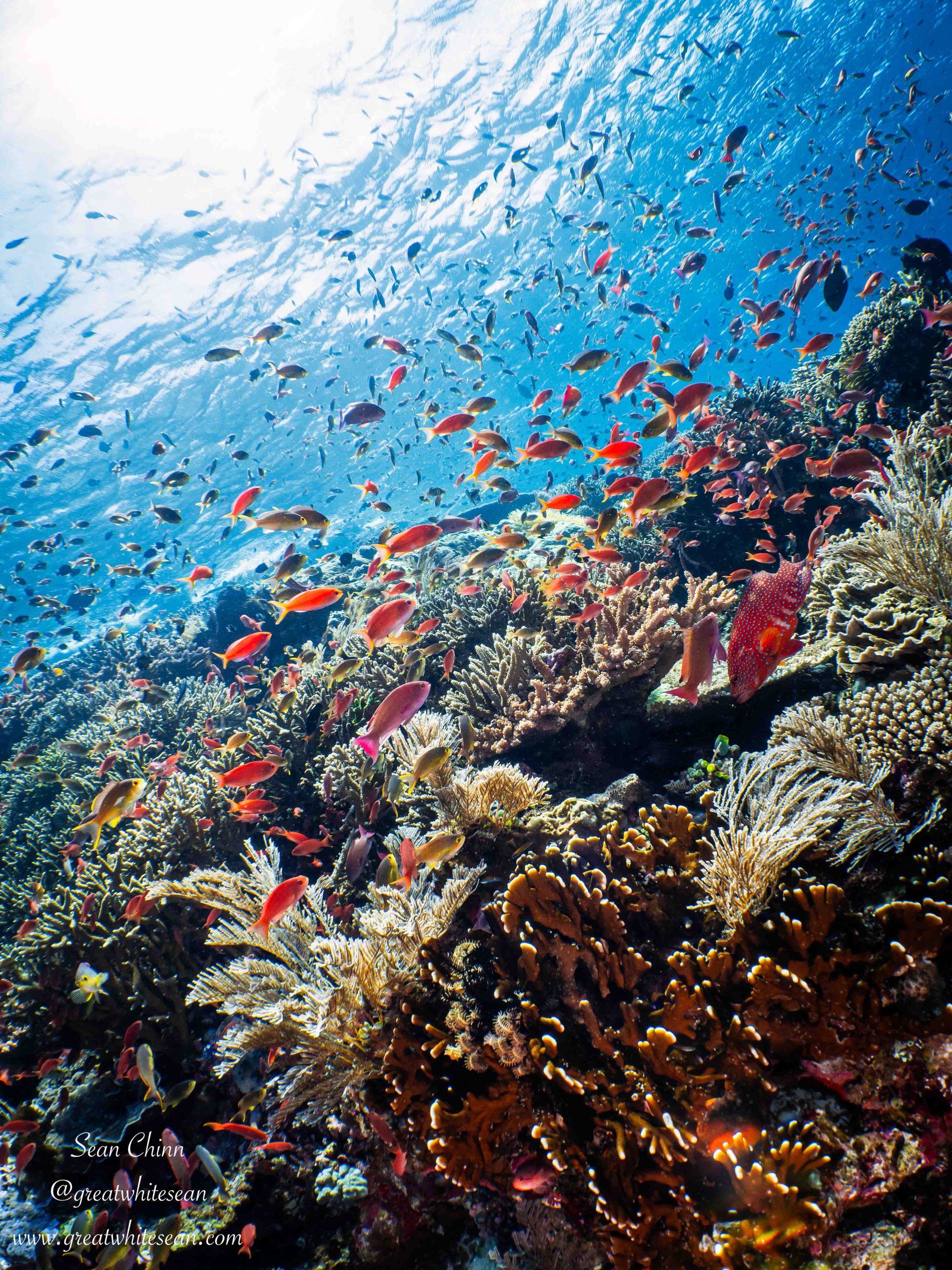
Whitetip reef sharks, scorpionfish, a giant pufferfish, moray eels and more made sure it wasn’t all about the turtles. And, to be honest, the dancing anthias on top of ‘Batu Balong’ amongst the pristine hard coral provided the bliss on the safety stop. A delightful end before disappointedly, I finally got unlucky with manta rays on dive three. We were at ‘Karang Makassar’ in the hope of drifting along the rubble and sand to get lucky with a moment with some majestic mantas. I’m normally quite lucky with manta rays and have had some pretty wild encounters around the world over my diving life. However, this time nature unfortunately didn’t play ball. Fingers crossed for next time!!
Thankfully it didn’t take away from what was another amazing day in Komodo. A sunset trek on Gili Lawa Darat got us back on land and we enjoyed the amazing scenery. Incredible views over the bay and the island resembling a snake head were made even more enjoyable by yet another gorgeous sunset. With deer roaming free, it was a great mini adventure, getting a close-up view of these rugged savannah islands before another fantastic night dive at Komodo Bay.
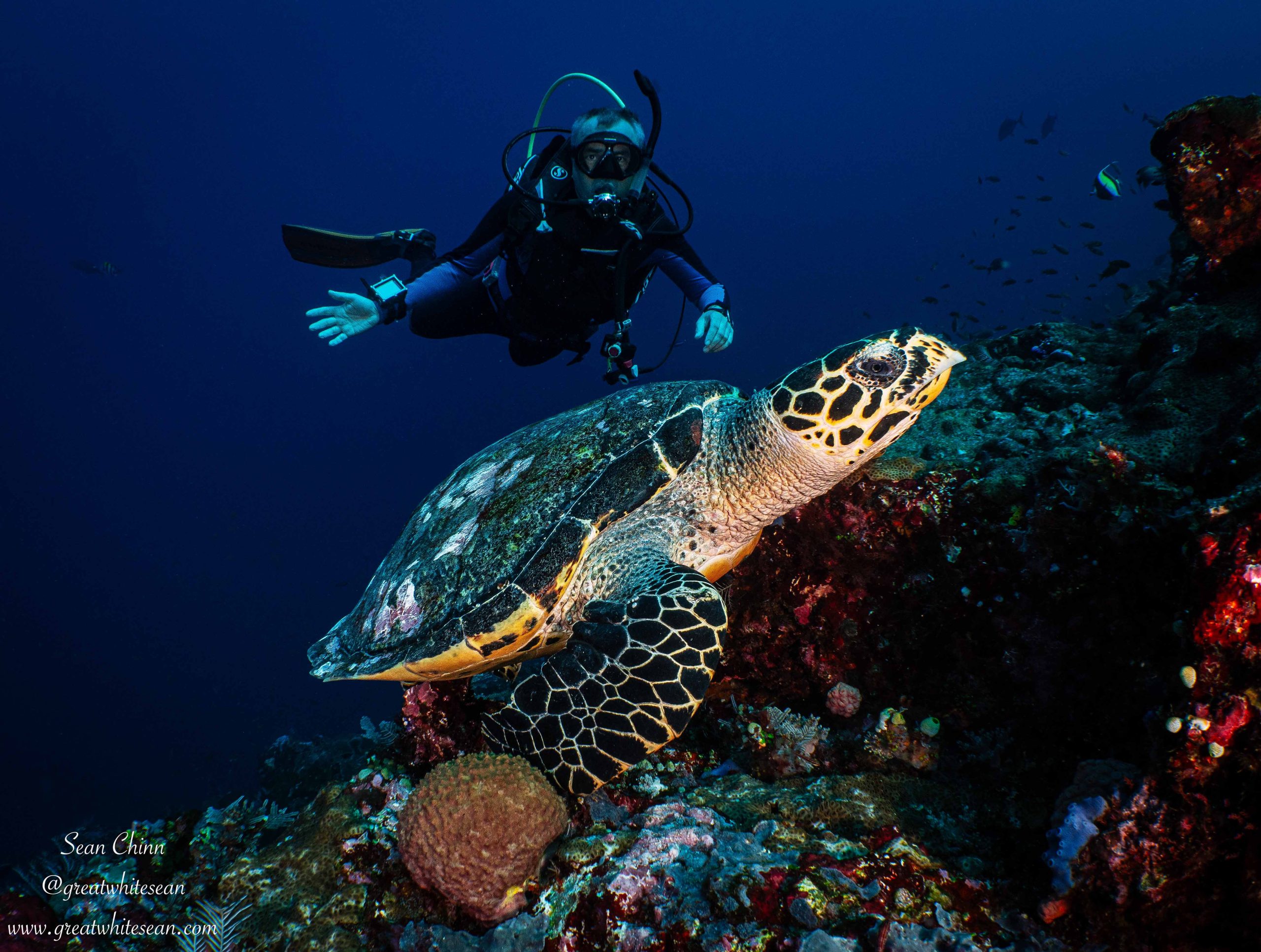
Numerous nudibranch were spotted and even a flatworm working its way over a scorpionfish’s head and eye provided some funny entertainment. I’m a sucker for a cuttlefish, so getting the chance to see and photograph a small one is always special. However, the most unique critter was the Lembeh sea dragon. Such a cute and surreal-looking creature that unfortunately wasn’t in a great position for photography. Hopefully I’ll get another chance one day and capture its unique beauty.
What a great start to life in Komodo onboard La Galigo. Be sure to stay tuned for part 2 and see what delights awaited us.
For more information about diving in Komodo:
Sean Chinn Instagram: @greatwhitesean
Email: sean@greatwhitesean.com
Whatsapp: +62 812 2000 2025
